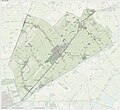|
Ten Boer
Ten Boer (Dutch pronunciation: [tɛmˈbuːr] ⓘ) is a village and a former municipality in the northeastern Netherlands, in the province of Groningen. The municipality had a population of data missing in 2021; the village of Ten Boer has approximately 4,600 inhabitants. In 2019, it was merged into municipality of Groningen.[3] HistoryThe village was first mentioned in 1301 as "conventum de Bure", and means "near the house".[4] Ten Boer is a terp (artificial living hill) village on a grid structure.[5] In 1301, a Benedictine monastery for nuns was established in Ten Boer. In 1485, it was incorporated into the monastery of Thesinge.[6] Around 1425, the Damsterdiep, a canal from Groningen to Delfzijl, was dug and the village received its current shape.[5] The Dutch Reformed church is the former monastery church, and dates from the 13th century. The church was modified in 1565. The tower was demolished around 1800, and in 1810, a ridge turret was placed on the roof instead.[5] Ten Boer was home to 279 people in 1840.[3] The former town hall is an L-shaped building with tower from 1911. It was influenced by Berlage and Jugendstil.[5] Ten Boer was an independent municipality until 2019 when it was merged into Groningen.[3] Former population centresGarmerwolde, Lellens, Sint Annen, Ten Boer, Ten Post, Thesinge, Winneweer, Wittewierum and Woltersum. Notable people from Ten Boer
Gallery
References
External links
|
||||||||||||||||||||||||||||||||||||||||||








